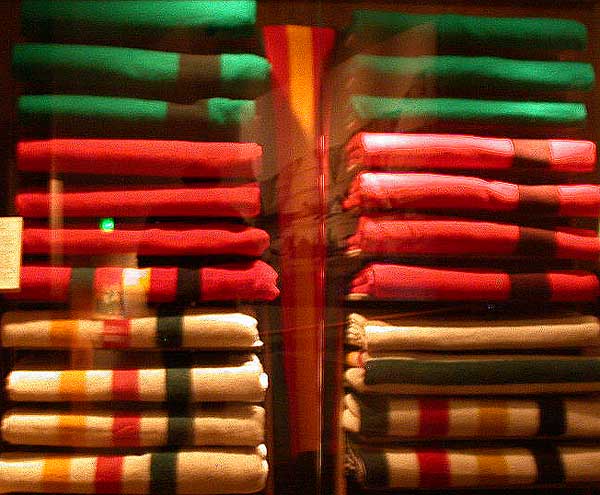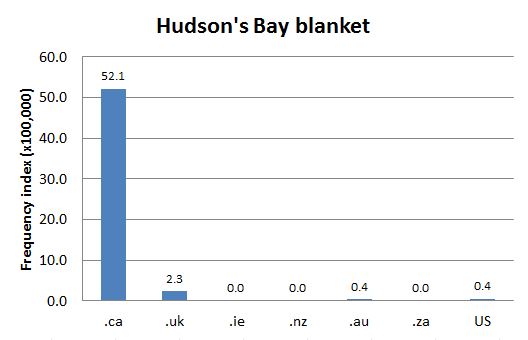DCHP-2
Hudson's Bay blanket DCHP-2 (November 2016)
1 n. — originally Fur trade
a type of woollen blanket sold by the Hudson's Bay Company (see Image 1).
Type: 1. Origin — The Hudson's Bay blanket, known in full as the Hudson's Bay Company point blanket, was introduced to the fur trade in 1780 (see HBC Heritage reference). A blanket's "points", according to a system originally developed in France in the 1700s, were indigo lines woven into the sides to indicate the overall size of the finished product. One point typically measured four to five inches and the "standard measurements for a pair of 1 point blankets was: 2 ft. 8 in. wide by 8 ft. in length; with a weight of 3 lb. 1 oz. each" (see HBC Heritage reference, "The Point System").
Trade value varied from post to post and also depended on the quality of the actual blanket in conjunction with its size, but one "made beaver" (a whole pelt in good condition) was often enough for a 1-point blanket (see Parks Canada reference). The Hudson's Bay blankets came in several colours. They were were popular with Aboriginal peoples as trade goods as the durable fabric was used for making clothing, especially coats (see also blanket coat). The white ones were popular for making coats for winter hunting in the snow.
The striped style that the company is most famous for, a white background with bars of indigo, yellow, red and green (see the bottom of Image 1), was first introduced in 1800 (see HBC Heritage reference). At present, this "multistripe" version of the Hudson's Bay blanket is sold at HBC stores across Canada, along with a host of similar fashion and home decor products. The term is most frequent in Canada (see Chart 1).
See also COD-2, s.v. "Hudson's Bay blanket", which is marked "Cdn".See also: beaver (def. 4) blanket coat Hudson's Bay (def. 3) point blanket
2 n. — historical
paper currency issued by the Hudson's Bay Company.
Type: 3. Semantic Change — Notes of various denominations were first issued by the Hudson's Bay Company after the establishment of the Red River Settlement in 1812, as the need for a form of currency arose among the colonists (Gingras 1968: 40). The notes were issued in the amounts of one shilling, five shillings, one pound, five pounds and ten pounds. Because the company's thick woollen blankets were a major trading commodity at the time, the term Hudson's Bay blankets was adopted as a nickname for the bills as well. As stated by Gingras (1968: 40), HBC halted circulation of the notes after 1870, when "the Company relinquished its territories to the Dominion of Canada".See also: Hudson's Bay bill
References:
- COD-2
- Gingras (1968)
- HBC Heritage "The Hudson's Bay Company Point Blanket: History" Accessed 7 Aug. 2014
- Parks Canada "Cultural Treasures: Point Blankets" Accessed 7 Aug. 2014
Images:

Image 1: Hudson's Bay blankets on display. Source: Wikimedia Commons. Photo: Decumanus
Chart 1: Internet Domain Search, 7 Aug. 2014
